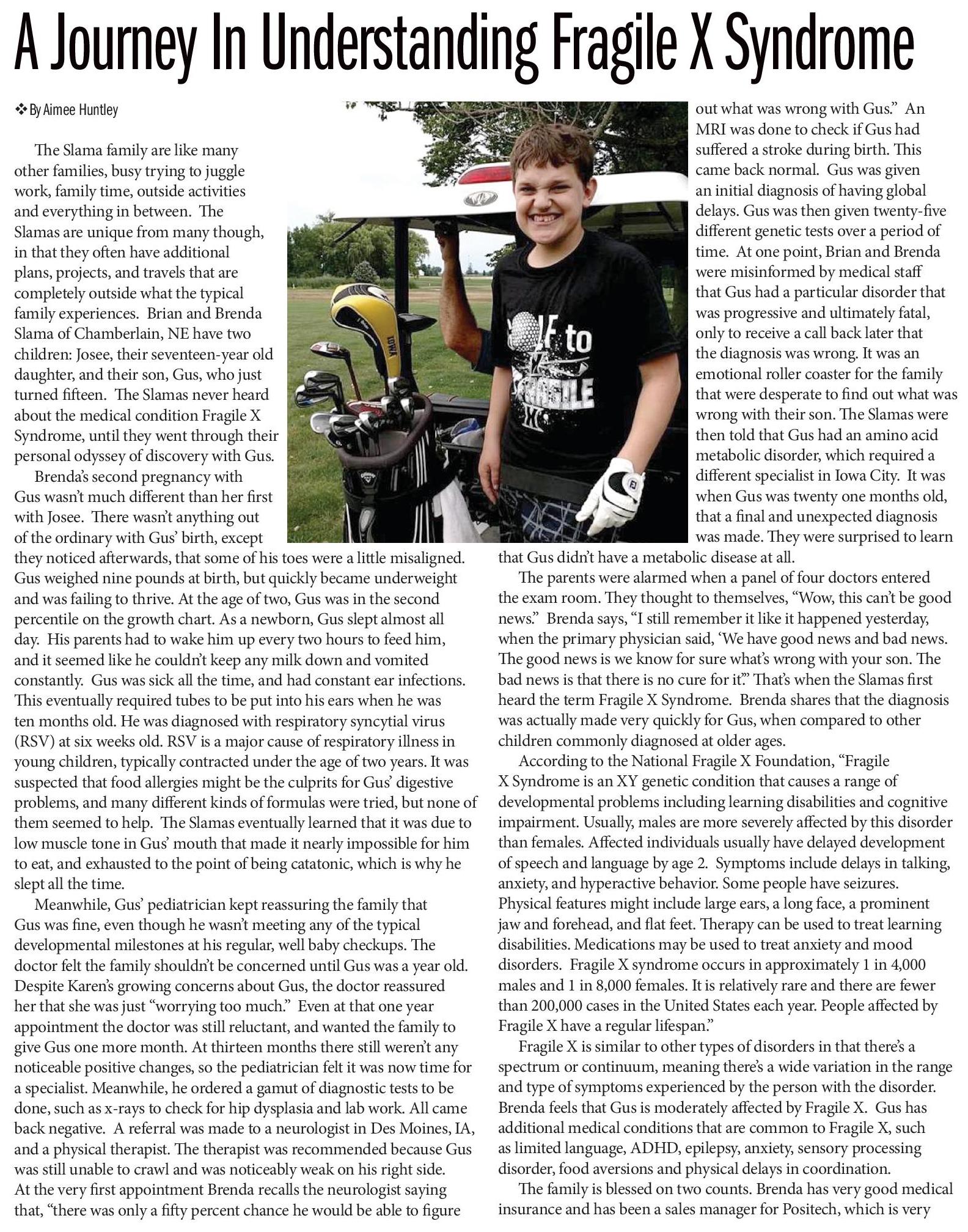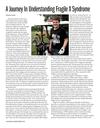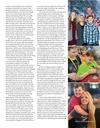011820_HER_A 18.pdf

A Journey In Understanding Fragile X Syndrome
vBy Aimee Huntley
The Slama family are like many
other families, busy trying to juggle
work, family time, outside activities
and everything in between. The
Slamas are unique from many though,
in that they often have additional
plans, projects, and travels that are
completely outside what the typical
family experiences. Brian and Brenda
Slama of Chamberlain, NE have two
children: Josee, their seventeen-year old
daughter, and their son, Gus, who just
turned fifteen. The Slamas never heard
about the medical condition Fragile X
Syndrome, until they went through their
personal odyssey of discovery with Gus.
Brenda’s second pregnancy with
Gus wasn’t much different than her first
with Josee. There wasn’t anything out
of the ordinary with Gus’ birth, except
they noticed afterwards, that some of his toes were a little misaligned.
Gus weighed nine pounds at birth, but quickly became underweight
and was failing to thrive. At the age of two, Gus was in the second
percentile on the growth chart. As a newborn, Gus slept almost all
day. His parents had to wake him up every two hours to feed him,
and it seemed like he couldn’t keep any milk down and vomited
constantly. Gus was sick all the time, and had constant ear infections.
This eventually required tubes to be put into his ears when he was
ten months old. He was diagnosed with respiratory syncytial virus
(RSV) at six weeks old. RSV is a major cause of respiratory illness in
young children, typically contracted under the age of two years. It was
suspected that food allergies might be the culprits for Gus’ digestive
problems, and many different kinds of formulas were tried, but none of
them seemed to help. The Slamas eventually learned that it was due to
low muscle tone in Gus’ mouth that made it nearly impossible for him
to eat, and exhausted to the point of being catatonic, which is why he
slept all the time.
Meanwhile, Gus’ pediatrician kept reassuring the family that
Gus was fine, even though he wasn’t meeting any of the typical
developmental milestones at his regular, well baby checkups. The
doctor felt the family shouldn’t be concerned until Gus was a year old.
Despite Karen’s growing concerns about Gus, the doctor reassured
her that she was just “worrying too much.” Even at that one year
appointment the doctor was still reluctant, and wanted the family to
give Gus one more month. At thirteen months there still weren’t any
noticeable positive changes, so the pediatrician felt it was now time for
a specialist. Meanwhile, he ordered a gamut of diagnostic tests to be
done, such as x-rays to check for hip dysplasia and lab work. All came
back negative. A referral was made to a neurologist in Des Moines, IA,
and a physical therapist. The therapist was recommended because Gus
was still unable to crawl and was noticeably weak on his right side.
At the very first appointment Brenda recalls the neurologist saying
that, “there was only a fifty percent chance he would be able to figure
18vHERVOICEvJANUARY/FEBRUARY 2020
out what was wrong with Gus.” An
MRI was done to check if Gus had
suffered a stroke during birth. This
came back normal. Gus was given
an initial diagnosis of having global
delays. Gus was then given twenty-five
different genetic tests over a period of
time. At one point, Brian and Brenda
were misinformed by medical staff
that Gus had a particular disorder that
was progressive and ultimately fatal,
only to receive a call back later that
the diagnosis was wrong. It was an
emotional roller coaster for the family
that were desperate to find out what was
wrong with their son. The Slamas were
then told that Gus had an amino acid
metabolic disorder, which required a
different specialist in Iowa City. It was
when Gus was twenty one months old,
that a final and unexpected diagnosis
was made. They were surprised to learn
that Gus didn’t have a metabolic disease at all.
The parents were alarmed when a panel of four doctors entered
the exam room. They thought to themselves, “Wow, this can’t be good
news.” Brenda says, “I still remember it like it happened yesterday,
when the primary physician said, ‘We have good news and bad news.
The good news is we know for sure what’s wrong with your son. The
bad news is that there is no cure for it’.” That’s when the Slamas first
heard the term Fragile X Syndrome. Brenda shares that the diagnosis
was actually made very quickly for Gus, when compared to other
children commonly diagnosed at older ages.
According to the National Fragile X Foundation, “Fragile
X Syndrome is an XY genetic condition that causes a range of
developmental problems including learning disabilities and cognitive
impairment. Usually, males are more severely affected by this disorder
than females. Affected individuals usually have delayed development
of speech and language by age 2. Symptoms include delays in talking,
anxiety, and hyperactive behavior. Some people have seizures.
Physical features might include large ears, a long face, a prominent
jaw and forehead, and flat feet. Therapy can be used to treat learning
disabilities. Medications may be used to treat anxiety and mood
disorders. Fragile X syndrome occurs in approximately 1 in 4,000
males and 1 in 8,000 females. It is relatively rare and there are fewer
than 200,000 cases in the United States each year. People affected by
Fragile X have a regular lifespan.”
Fragile X is similar to other types of disorders in that there’s a
spectrum or continuum, meaning there’s a wide variation in the range
and type of symptoms experienced by the person with the disorder.
Brenda feels that Gus is moderately affected by Fragile X. Gus has
additional medical conditions that are common to Fragile X, such
as limited language, ADHD, epilepsy, anxiety, sensory processing
disorder, food aversions and physical delays in coordination.
The family is blessed on two counts. Brenda has very good medical
insurance and has been a sales manager for Positech, which is very


























 Previous Page
Previous Page

